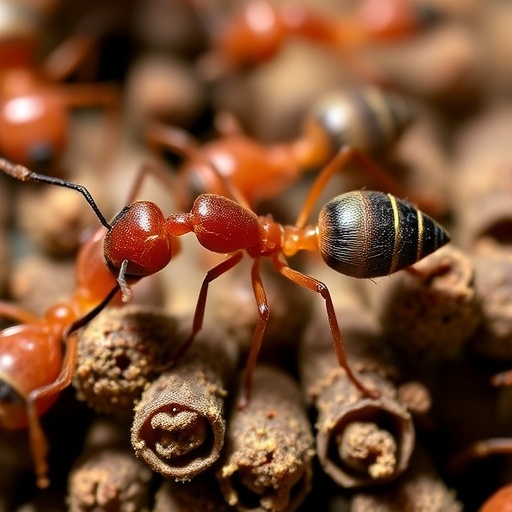Ants have long been admired for their intricate social structures and impressive collective behaviors, but new research from the University of Bristol has uncovered a remarkable adaptation that takes their ingenuity to a new level. Published recently in the prestigious journal Science, the study reveals that ant colonies actively remodel the architecture of their nests to combat the spread of disease. This architectural remodeling is a sophisticated, unrecognized layer of what scientists now term “social immunity,” showcasing ants’ ability to modify their physical environment in response to pathogen threats.
The research team deployed advanced micro-computed tomography (micro-CT) to achieve high-resolution, three-dimensional visualizations of ant nest structures. This imaging technology provided unprecedented insights into nest morphologies, particularly comparing nests constructed by healthy colonies against those exposed to infectious fungal spores. The scans unveiled striking differences: colonies under pathogenic threat expanded and spatially separated their nest entrances, with a notable decrease in direct connections between chambers. These modifications suggest a strategic reorganization intended to compartmentalize the nest and inhibit disease transmission pathways.
Dr. Luke Leckie, a doctoral researcher leading the study, comments on the significance of these findings, emphasizing the groundbreaking nature of environmental modification in non-human animals as a disease mitigation strategy. While it is well documented that ants have numerous behavioral adaptations to pathogens — such as grooming each other to remove fungal spores or isolating infected individuals — this is the inaugural demonstration of ants physically reconstructing their nests to reduce contagion risks.
In natural settings, ant nests serve multiple specialized functions: chambers are allocated for brood rearing, food storage, and as passages for workers to move efficiently. By redesigning these spatial compartments, ants effectively restrict pathogen movement within their colonies. The research underscores the complexity inherent in these constructions and the ants’ ability to optimize nest architecture dynamically in response to environmental health threats.
This discovery builds on earlier behavioral observations that suggested soil conditions like temperature and nutrient availability influence nest excavation. The present work extends this understanding to include the presence of pathogens as a critical environmental factor prompting architectural changes. By integrating pathogen exposure into their nest-building decisions, ants display a sophisticated form of environmental engineering that parallels human epidemic mitigation strategies, albeit driven by evolutionary pressures rather than conscious planning.
To test the influence of pathogen exposure on nest structure and disease spread, the researchers set up controlled experiments using groups of 180 worker ants in soil-filled containers. After an initial 24-hour excavation period, an additional 20 ants were introduced, with one group’s soil laced with fungal spores. Over six subsequent days, the team monitored nest development and conducted serial micro-CT scans. These scans allowed construction of detailed 3D models that were used in simulation algorithms to predict disease transmission under different architectural scenarios.
Simulation results confirmed the functional benefits of the altered nest design. The more dispersed entrances and reduced inter-chamber connectivity significantly lessened the probability of individuals encountering lethal doses of pathogens. This architectural immunity effectively protects the colony’s vulnerable members, including larvae and food stores, thereby sustaining colony resilience in adverse conditions.
Intriguingly, the study also demonstrated an amplifying effect when ant self-isolation behavior was incorporated into simulations. This behavior, where infected ants retreat to minimize contact, synergizes with the compartmentalized nest layout to further curtail transmission. The combined behavioral and architectural adaptations compound their protective effects, highlighting the multifaceted nature of social immunity in ants.
Beyond immediate biological insights, this research offers a compelling parallel to human urban planning and epidemic prevention. Like ant nests, human settlements comprise complex networks designed to facilitate the flow of resources, information, and people. Yet these same networks can accelerate pathogen spread. By understanding how social insects negotiate this balance — optimizing connectivity while limiting contagion — architects and epidemiologists can draw inspiration for more resilient design strategies in human infrastructure to mitigate epidemic risks.
This study heralds a new appreciation for the intricate relationship between environmental modification and disease management within social animal systems. It also invites a reevaluation of ecosystem engineering, classically thought to be primarily adaptive for resource acquisition or shelter, now recognized as a critical factor in social health maintenance. The ants’ capacity to adapt their three-dimensional living spaces under duress highlights both evolutionary innovation and the potential for biomimetic applications.
The findings spark numerous avenues for future research, including how these architectural changes evolve across different ant species and environments, and to what extent other social animals might employ similar environmental modifications to combat pathogens. Furthermore, researchers are keen to explore the molecular and sensory cues ants use to detect pathogens and trigger these structural changes, promising deeper insights into the integration of behavior, ecology, and architecture.
In sum, ants are not merely passive victims of microbial threats but dynamic engineers of their habitats, leveraging complex spatial strategies to safeguard colony health. This novel “architectural immunity” paradigm enhances our understanding of disease ecology and social organism resilience, underscoring the sophisticated interplay of behavior and environment in evolutionary biology.
Subject of Research: Animals
Article Title: ‘Architectural Immunity: ants alter their nest networks to fight epidemics’
News Publication Date: 15-Oct-2025
Web References: http://dx.doi.org/10.1101/2024.08.30.610481
Image Credits: University of Bristol
Keywords: Evolutionary biology
Tags: ant nest structure analysisant social immunity strategiesarchitectural remodeling in ant nestscollective behavior in antsdisease mitigation strategies in naturedisease spread prevention in ant coloniesenvironmental adaptation in non-human animalsfungal spores impact on ant coloniesmicro-computed tomography in biologynest compartmentalization techniquespathogen response in social insectsUniversity of Bristol ant research





